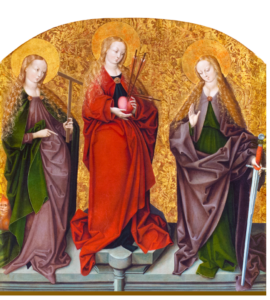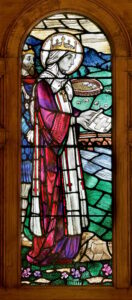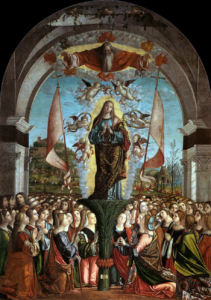Object of the Month: August 2023
St. Margaret, St. Ursula, and St. Agnus
Oil on panel
Unknown Rhenish School
Rhenish, active c. 1500
In last month’s article on the companion panel by this Rhenish Master, we discovered that context reveals a wealth of information. We also learned that although there are common symbols in Christian iconography, most saints have one or more distinct attributes that alert us to their identity. Such clues are particularly important when seeking to determine saints with common names like Catherine—or Margaret.
There are two Margaret’s mentioned in traditional hagiographies: St. Margaret of Antioch and St. Margaret of Scotland. The far-left figure in this panel is most likely St. Margaret of Scotland. How do we know? According to legend, Margaret of Antioch was a young beauty who endured several harrowing ordeals before being martyred, including being swallowed by a dragon. The absence of this mythical beast, which became Margaret of Antioch’s distinguishing attribute, provides the first clue. In addition, there are no accompanying symbols indicating that the figure in this panel was martyred (e.g., no laurel wreath, sword, etc.). This elegantly posed Margaret simply points to the cross she holds. The cross is, of course, a universal symbol of Christianity but it is also an integral part of Margaret of Scotland’s life and legacy.
A relative of Edward the confessor, Margaret and her brother were forced to flee England when William the Conqueror invaded the realm. They took refuge in Scotland at the court of King Malcolm Canmore where Margaret “as beautiful as she was good and accomplished” soon captured the heart the king. The two were married in 1070. Alban Butler notes, “This marriage was fraught with great blessing for Malcolm and for Scotland. He was rough and uncultured but his disposition was good, and Margaret through the great influence she acquired over him, softened his temper, polished his manners, and rendered him one of the most virtuous kings who ever occupied the Scottish throne. . . . What she did for her husband Margaret also did in a great measure for her adopted country” (Butler, p. 182). She encouraged (and in some cases spearheaded) much needed reforms in the arts, education, and religion. She would die just four days after her husband, who had been slain while trying to stave off an attack on their castle. In addition to a cross, Margaret is often shown wearing her crown as in the stained-glass panel to the right from the Royal Collection Trust. (For a more detailed overview of Margaret’s life and times see David McRoberts historical essay, “St. Margaret Queen of Scotland.”)
Unlike Margaret of Scotland, there is considerable doubt regarding the historicity of the center figure St. Ursula. According to legend Ursula was the daughter of a Christian monarch who caught the eye of a pagan king. Upon his proposal Ursula asked (and was granted) a three-year delay. During this time of reprieve, she sailed off to visit the shrines of the saints. Accompanying her on the journey were ten noble ladies-in-waiting and several thousand companions of “lower birth.” At the end of the grace period, this formidable entourage turned toward home. However, a storm-tossed sea drove them off course forcing them to disembark at Cologne. While awaiting favorable winds, they crossed the Alps to visit the tombs of the apostles in Rome. Unfortunately when the sojourners returned to Cologne, they found the city besieged by the Huns—whose chieftain demanded that Ursula become his wife. When she refused, she and her fellow travelers “were set upon and massacred for their Christianity by the heathen Huns. Then the barbarians were dispersed by angels, the citizens buried the martyrs, and a church was built in their honor” (Butler, 130).
In this panel, Ursula is pictured holding a heart pierced with the three arrows the Chieftain supposedly used to kill her. In addition to this distinguishing attribute Ursula is also sometimes painted surrounded by her martyred entourage. The painting to the left by Vittore Carpaccio is a good illustration. Carpaccio’s rendering of Ursula is part of a famous cycle in the Gallerie dell’ Accademia in Venice—which is currently undergoing restoration. The cycle consists of nine paintings from Ursula’s life. You can read more about the history and preservation of this impressive undertaking at Save Venice: Conserving Art, Celebrating History.
The third figure, St. Agnes, has always been extremely popular in the lexicon of saints. According to the eminent church father Augustine, she was just thirteen when martyred. Her death likely occurred in Rome at the outset of Diocletian’s persecution which began in March of 303 AD. Though just a girl, “her riches and beauty excited the young noblemen of the first families in Rome to contend as rivals for her hand” (Butler, p. 96). But Agnes had resolved not to marry and when her suitors failed to persuade her otherwise, they went as one before the governor to accuse her of being a Christian. The wily politician at first endeavored to procure her recantation through seductive promises of worldly treasure. To no avail. “He then made use of threats, . . .terrible fires were made, and iron hooks, racks and other instruments of torture displayed before her, with threats of immediate execution. The heroic child surveyed them undismayed” (Butler, p. 96). The profligate politician then sent her to a house of prostitution, but any who sought to harm her, “were seized with such awe at the sight of the saint that they durst not approach her” (Ibid, p. 96). She was sent back to the governor unscathed which so stoked his rage that he had her beheaded, making the sword one of her defining attributes. She is also often pictured with a lamb (relating her name to the word agnus which is Latin for lamb). M&G’s St. Michael the Archangel and St. Agnes by the Flemish painter Colijin de Coter highlights this symbol. Although modern authorities tend to dismiss many of the particulars of Agnes’s story, there is little doubt that she was martyred during the Roman persecution and that she was subsequently buried in one of the catacombs just outside of Rome along the Via Nomentana.
Donnalynn Hess, Director of Education
Reference:
One Hundred and One Saints: Their Lives and Likenesses Drawn from Butler’s “Lives of the Saints and Great Works of Western Art.” A Bulfinch Press Book: Little, Brown and Company (Compilation Copyright 1993).
Published 2023


